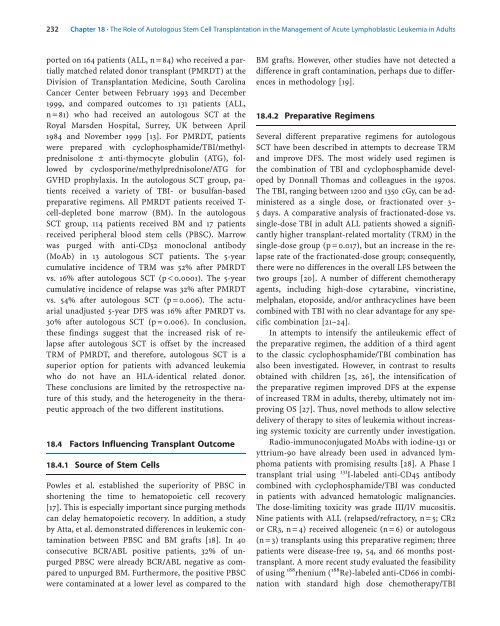Acute Leukemias - Republican Scientific Medical Library
Acute Leukemias - Republican Scientific Medical Library
Acute Leukemias - Republican Scientific Medical Library
Create successful ePaper yourself
Turn your PDF publications into a flip-book with our unique Google optimized e-Paper software.
232 Chapter 18 · The Role of Autologous Stem Cell Transplantation in the Management of <strong>Acute</strong> Lymphoblastic Leukemia in Adults<br />
ported on 164 patients (ALL, n=84) who received a partially<br />
matched related donor transplant (PMRDT) at the<br />
Division of Transplantation Medicine, South Carolina<br />
Cancer Center between February 1993 and December<br />
1999, and compared outcomes to 131 patients (ALL,<br />
n=81) who had received an autologous SCT at the<br />
Royal Marsden Hospital, Surrey, UK between April<br />
1984 and November 1999 [13]. For PMRDT, patients<br />
were prepared with cyclophosphamide/TBI/methylprednisolone<br />
± anti-thymocyte globulin (ATG), followed<br />
by cyclosporine/methylprednisolone/ATG for<br />
GVHD prophylaxis. In the autologous SCT group, patients<br />
received a variety of TBI- or busulfan-based<br />
preparative regimens. All PMRDT patients received Tcell-depleted<br />
bone marrow (BM). In the autologous<br />
SCT group, 114 patients received BM and 17 patients<br />
received peripheral blood stem cells (PBSC). Marrow<br />
was purged with anti-CD52 monoclonal antibody<br />
(MoAb) in 13 autologous SCT patients. The 5-year<br />
cumulative incidence of TRM was 52% after PMRDT<br />
vs. 16% after autologous SCT (p < 0.0001). The 5-year<br />
cumulative incidence of relapse was 32% after PMRDT<br />
vs. 54% after autologous SCT (p = 0.006). The actuarial<br />
unadjusted 5-year DFS was 16% after PMRDT vs.<br />
30% after autologous SCT (p = 0.006). In conclusion,<br />
these findings suggest that the increased risk of relapse<br />
after autologous SCT is offset by the increased<br />
TRM of PMRDT, and therefore, autologous SCT is a<br />
superior option for patients with advanced leukemia<br />
who do not have an HLA-identical related donor.<br />
These conclusions are limited by the retrospective nature<br />
of this study, and the heterogeneity in the therapeutic<br />
approach of the two different institutions.<br />
18.4 Factors Influencing Transplant Outcome<br />
18.4.1 Source of Stem Cells<br />
Powles et al. established the superiority of PBSC in<br />
shortening the time to hematopoietic cell recovery<br />
[17]. This is especially important since purging methods<br />
can delay hematopoietic recovery. In addition, a study<br />
by Atta, et al. demonstrated differences in leukemic contamination<br />
between PBSC and BM grafts [18]. In 40<br />
consecutive BCR/ABL positive patients, 32% of unpurged<br />
PBSC were already BCR/ABL negative as compared<br />
to unpurged BM. Furthermore, the positive PBSC<br />
were contaminated at a lower level as compared to the<br />
BM grafts. However, other studies have not detected a<br />
difference in graft contamination, perhaps due to differences<br />
in methodology [19].<br />
18.4.2 Preparative Regimens<br />
Several different preparative regimens for autologous<br />
SCT have been described in attempts to decrease TRM<br />
and improve DFS. The most widely used regimen is<br />
the combination of TBI and cyclophosphamide developed<br />
by Donnall Thomas and colleagues in the 1970s.<br />
The TBI, ranging between 1200 and 1350 cGy, can be administered<br />
as a single dose, or fractionated over 3–<br />
5 days. A comparative analysis of fractionated-dose vs.<br />
single-dose TBI in adult ALL patients showed a significantly<br />
higher transplant-related mortality (TRM) in the<br />
single-dose group (p = 0.017), but an increase in the relapse<br />
rate of the fractionated-dose group; consequently,<br />
there were no differences in the overall LFS between the<br />
two groups [20]. A number of different chemotherapy<br />
agents, including high-dose cytarabine, vincristine,<br />
melphalan, etoposide, and/or anthracyclines have been<br />
combined with TBI with no clear advantage for any specific<br />
combination [21–24].<br />
In attempts to intensify the antileukemic effect of<br />
the preparative regimen, the addition of a third agent<br />
to the classic cyclophosphamide/TBI combination has<br />
also been investigated. However, in contrast to results<br />
obtained with children [25, 26], the intensification of<br />
the preparative regimen improved DFS at the expense<br />
of increased TRM in adults, thereby, ultimately not improving<br />
OS [27]. Thus, novel methods to allow selective<br />
delivery of therapy to sites of leukemia without increasing<br />
systemic toxicity are currently under investigation.<br />
Radio-immunoconjugated MoAbs with iodine-131 or<br />
yttrium-90 have already been used in advanced lymphoma<br />
patients with promising results [28]. A Phase I<br />
transplant trial using 131 I-labeled anti-CD45 antibody<br />
combined with cyclophosphamide/TBI was conducted<br />
in patients with advanced hematologic malignancies.<br />
The dose-limiting toxicity was grade III/IV mucositis.<br />
Nine patients with ALL (relapsed/refractory, n=5; CR2<br />
or CR3, n=4) received allogeneic (n = 6) or autologous<br />
(n = 3) transplants using this preparative regimen; three<br />
patients were disease-free 19, 54, and 66 months posttransplant.<br />
A more recent study evaluated the feasibility<br />
of using 188 rhenium ( 188 Re)-labeled anti-CD66 in combination<br />
with standard high dose chemotherapy/TBI
















